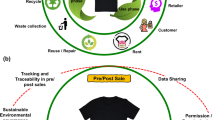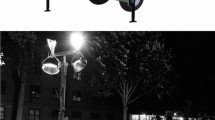Abstract
This paper raises the importance of the built environment and aesthetic matters in the debate on the competitiveness of cities. The quality of a living environment is an important factor in creating competitiveness and the reputation of places. Cities compete for the favours of inhabitants, companies and visitors, and an attractive urban milieu could attract important and creative human resources to a city. This paper defines the concept of city design management as a conceptual way of emphasising the importance of designing an attractive living environment. City design management means all-inclusive managing of the city design. It gives a city the opportunity to be distinguished from other cities. The elements of city design management are city topography, general impression, presentation and management.

Similar content being viewed by others
References
Ahopelto, J. (2002) ‘Design management as a strategic instrument’, Acta Wasaensia, No. 99, Industrial Management 4, Universitas Wasaensis, Vaasa.
Äikäs, T. (2001) ‘Imagosta maisemaan. Esimerkkeinä Turun ja Oulun kaupunki-imagojen rakentaminen’, Akateeminen väitöskirja, Nor.
Andelmin, M. -L. and Casagrande, U. (1994) ‘Toimintaympäristö’, in Poikolainen, L. (ed.) ‘Design management, Yrityskuvasta kilpailuvaltti’, Kustannusosakeyhtiö Otava, Keuruu, Finland, pp. 139–194.
Anholt, S. (2004) ‘Branding places and nations’, in Clifton, R., Simmons, J. and Ahmad, S. (eds), ‘Brands and Branding’, The Economist Series,Bloomberg Press, Princeton, NJ, pp. 213–226.
Anholt, S. (2007) ‘Competitive Identity. The New Brand Management for Nations, Cities and Regions’, Palgrave Macmillan, Basingstoke, UK.
Aula, P. and Harmaakorpi, V. (2008) ‘Innovative milieu — A view on regional reputation building: A case study of the Lahti urban region’, Regional Studies, in press.
Aula, P. and Heinonen, J. (2002) ‘Maine: menestystekijä’, WSOY, Helsinki, Finland.
Aula, P. and Mantere, S. (2005) ‘Hyvä yritys: strateginen maineenhallinta’, WSOY, Helsinki, Finland.
Camagni, R. (2002) ‘On the concept of territorial competitiveness: Sound or misleading?’ Urban Studies, Vol. 39, No. 13, pp. 2395–2411.
Castells, M. (1996) ‘The Information Age: Economy, Society and Culture Volume 1. The Rise of the Network Society’, Blackwell Publishers, Oxford, UK.
Davies, G., Chun, R., da Silva, R. and Roper, S. (2003) ‘Corporate Reputation and Competitiveness’, Routledge, London, UK.
Encyclopaedia Britannica. (1989) Encyclopaedia Britannica, Inc., Chicago, IL, (3/334).
Florida, R. (2002) ‘The Rise of Creative Class. And How it is Transforming Work, Leisure, Community and Every Day Life’, Basic Books, New York, NY.
Fombrun, C. (1996) ‘Reputation: Realizing Value from the Corporate Image’, Harvard Business School Press, Boston, MA.
Gilmore, F. (2002) ‘Branding for success’, in Morgan, N., Pritchard, A. and Pride, R. (eds), ‘Destination Branding. Creating the Unique Destination Proposition’, Butterworth Heinemann, Oxford, UK, pp. 57–65.
Gorb, P. (1990) ‘What is design management’, in Aitonurmi, R. (ed.) ‘Design Management. A Key to Success. Design as Corporate Strategy’, University of Industrial Arts Helsinki, UIAH, Helsinki, pp. 9–16.
Hall, J. (1990) ‘Design as a catalyst to the management of change’, in Aitonurmi, R. (ed.) ‘Design Management. A Key to Success. Design as Corporate Strategy’, University of Industrial Arts Helsinki, UIAH, Helsinki, pp. 39–47.
Harmaakorpi, V. (2006) ‘The regional development method as a tool for regional innovation policy’, European Planning Studies, Vol. 14, No. 8, pp. 1085–1104.
Hiltunen, H. and Markkanen, T. -R. (1994) ‘Käyttäytyminen’, in Poikolainen, L. (ed.) ‘Design management. Yrityskuvasta kilpailuvaltti’, Kustannusosakeyhtiö Otava, Keuruu, Finland, pp. 195–215.
Hospers, G. -J. (2003) ‘Creative cities in Europe. Urban competitiveness in the knowledge economy’, Intereconomics, Vol. 38, No. 5, pp. 260–269.
Karisto, A. (2004) ‘Arkiviihtyvyyden aika, kaupunkipolitiikan pehmeä puoli’, in Antikainen, J. and Pyöriă, T. (eds.) ‘Kaupunkiseutujen kasvun aika’, Sisäasianministeriön julkaisuja 14/2004,Alueiden kehittäminen, Helsinki, Finland, pp. 31–36.
Karvonen, E. (1999) ‘Elämää mielikuvayhteiskunnassa: Imago ja maine menestystekijöinä myöhäismodernissa maailmassa’, Gaudeamus, Helsinki, Finland.
Kotler, P., Asplund, C., Rein, I. and Haider, D. (1999) ‘Marketing Places Europe’, Pearson Education Ltd, London, UK.
Kotter, J. P. (1988) ‘The Leadership Factor’, Free Press, New York, NY.
Kostiainen, J. (2002) ‘Urban Economic Development Policy in the Network Society’, Tekniikan akateemisten liitto, Tampere, Finland.
Krugman, P. (1998) ‘Pop Internationalism’, MIT Press, Cambridge, MA.
Larkin, J . (2003) “Strategic Reputation Risk Management”, Palgrave Macmillan: Basingstoke.
Lawrence, P. (1990) ‘Design as corporate strategy’, in Aitonurmi, R. (ed.) ‘Design Management. A Key to Success. Design as Corporate Strategy’, University of Industrial Arts Helsinki, UIAH, pp. 19–29.
Linnamaa, R. (1999) ‘Kaupunkiseudun kilpailukyvyn rakenteelliset ja dynaamiset elementit’, in Sotarauta, M. (ed.) ‘Kaupunkiseutujen kilpailukyky ja johtaminen tietoyhteiskunnassa’, Suomen Kuntaliitto, ACTA No. 106, Helsinki, Finland.
Lundvall, B. -Å. and Johnson, B. (1994) ‘The learning economy’, Journal of Industry Studies, Vol. 1, No. 2, pp. 23–42.
Markkanen, T. -R. (1998) ‘Corporate identity: A process of strategic interpretation in an MNC’, Acta Universitatis Oeconomicae Helsingiensis A-145, Helsinki School of Economics and Business Administration.
Maula, J. (2004) Lecture on 20th September, 2004 by Professor Maula, Tampere University of Technology, Department of Architecture, The Institute of Urban Planning and Design.
Morgan, N. and Pritchard, A. (2002) ‘Contextualizing destination branding’, in Morgan, N., Pritchard, A. and Pride, R. (eds), ‘Destination Branding. Creating the Unique Destination Proposition’, Butterworth Heinemann, Oxford, UK, pp. 11–41.
Niiniluoto, I. (2000) ‘Urbaanien arvojen mosaiikkia’, in Norri, M-R., Leiman, K. and Kärkkäinen, M. (eds.) ‘Puhutaan kaupungista/Talking About the City’, Helsingin kantakaupungin ajankohtaisia suunnitelmia, Helsingin kaupunki, Helsinki, Finland.
Olins, W. (1989) ‘Corporate Identity. Making Business Strategy Visible Through Design’, Thames and Hudson: London.
Parkerson, B. and Saunders, J. (2005) ‘City branding: Can goods and services branding models be used to brand cities?’ Place Branding, Vol. 1, No. 3, pp. 242–264.
Pellinen, J. (1994) ‘Esipuhe: Muotokulttuurin taitava soveltaminen on liiketoiminnan luonnollinen menestystekijä’, in Poikolainen, L. (ed.) ‘Design management. Yrityskuvasta kilpailuvaltti, Poikolainen, L. (ed.)’, Kustannusosakeyhtiö Otava, Keuruu, Finland, pp. 11–18.
Poikolainen, L. (ed.) (1994) ‘Johdatus design management –ajateluun’, in ‘Design management. Yrityskuvasta kilpailuvaltti’, Kustannusosakeyhtiö Otava, Keuruu, Finland, pp. 19–44.
Poikolainen, L. and Klippi, Y. (1994) ‘Viestintä', in Poikolainen, L. (ed.), ‘Design management. Yrityskuvasta kilpailuvaltti’, Kustannusosakeyhtiö Otava, Keuruu, Finland, pp. 89–137.
Rainisto, S. (2003) ‘Success factors of place marketing’, Doctoral Dissertations 2003/4, Helsinki University of Technology, Institute of Strategy and International Business, Espoo.
Raunio, M. (2001) ‘Asuin- ja elinympäristön laatu kaupunkiseutujen kilpailuetuna’, in Sotarauta, M. and Mustikkamäki, N. (eds), ‘Alueiden kilpailukyvyn kahdeksan elementtiä’, Suomen Kuntaliitto, ACTA No. 137, Helsinki, pp. 129–150.
Reich, R. (1993) ‘The Work of Nations. Preparing Ourselves for 21st Century Capitalism’, Alfred A. Knopf, New York, NY.
Roos, J. P. (2001) ‘Kuka kaipaa 70-luvun arkkitehtuuria?’, Helsingin Sanomat, Vieraskynä 24.4.2001.
Sepänmaa, Y. (1994) ‘Alligaattorin hymy, ympäristöestetiikan uusi aalto’, Helsingin yliopisto, Lahden tutkimus- ja koulutuskeskus, Gummerus Kirjapaino Oy, Jyväskylä, Finland.
Silander, M., Tervo, H. and Niittykangas, H. (1997) ‘Uusi aluepolitiikka ja yritysten sijaintikäyttäytyminen’, Keski-Suomen taloudellisen tutkimuskeskuksen julkaisuja 142, Jyväskylä, Finland.
Storper, M. (1997) ‘The Regional World: Territorial Development in a Global Economy’, The Guilford Press, New York, NY.
Turner, R. (1990) ‘Managing the corporate image’, in Aitonurmi, R. (ed.) ‘Design Management. A Key to Success. Managing the Corporate Image’, University of Industrial Arts Helsinki, Helsinki, UIAH, pp. 27–37.
Virtanen, P. (1999) ‘Kaupungin imago. Mikä tekee Pariisista Pariisin ja Pisasta Pisan’, Rakennustieto Oy, Helsinki, Finland.
Willmott, M. (2001) ‘Citizen Brands: Putting Society at the Heart of your Business’, John Wiley & Sons, Chichester, UK.
Author information
Authors and Affiliations
Rights and permissions
About this article
Cite this article
Harmaakorpi, V., Kari, K. & Parjanen, S. City design management as a local competitiveness factor. Place Brand Public Dipl 4, 169–181 (2008). https://doi.org/10.1057/pb.2008.7
Received:
Revised:
Published:
Issue Date:
DOI: https://doi.org/10.1057/pb.2008.7




